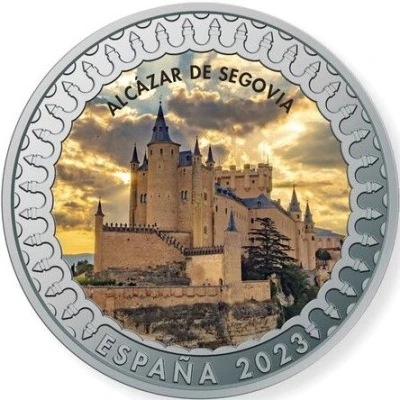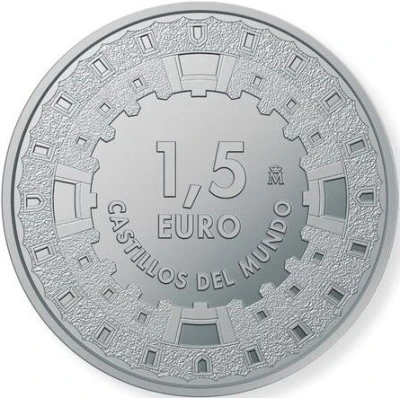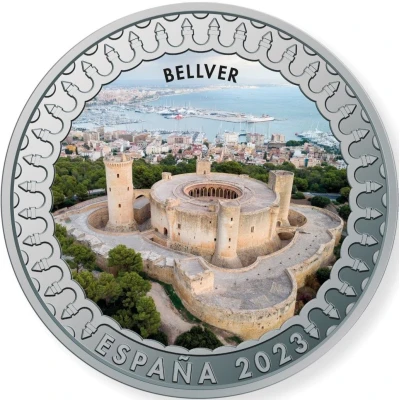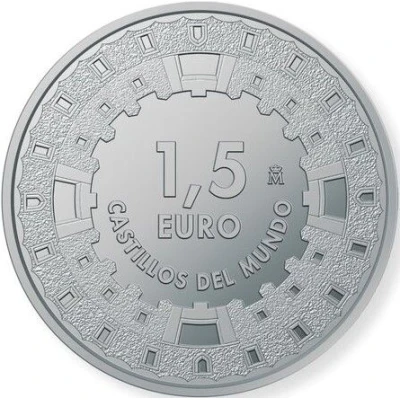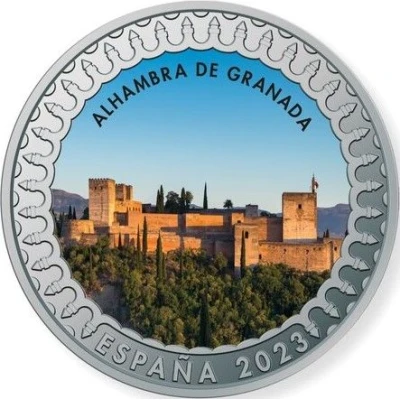
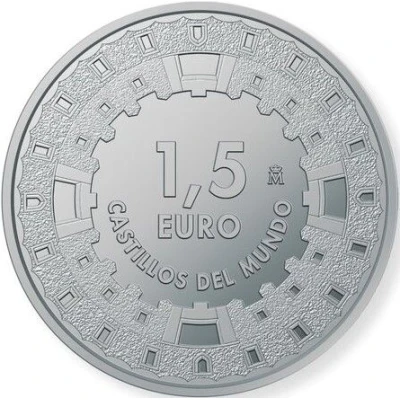

© Real Casa de la Moneda
1.5 Euro Alhambra of Granada
2023 year| Copper-nickel (75% copper, 25% nickel) | 15 g | 33 mm |
| Issuer | Spain |
|---|---|
| King | Felipe VI (2014-date) |
| Type | Non-circulating coin |
| Year | 2023 |
| Value | 1.5 Euro 1.50 EUR = USD 1.65 |
| Currency | Euro (2002-date) |
| Composition | Copper-nickel (75% copper, 25% nickel) |
| Weight | 15 g |
| Diameter | 33 mm |
| Shape | Round |
| Technique | Milled, Coloured |
| Orientation | Medal alignment ↑↑ |
| Updated | 2024-10-07 |
| Numista | N#383814 |
|---|---|
| Rarity index | 97% |
Reverse
On the outside part of the the reverse (common to all the coins), allegory of the structure of the castles.
Script: Latin
Lettering:
CASTILLOS DEL MUNDO
1,5 EURO
M
Translation: Castles of the World
Edge
Plain
Comment
Alhambra of Granada: The mention of Granada calls to mind the Alhambra, or is it the other way around? This unique wonder of the world, nestled between two rivers and with the Sierra Nevada mountains as an imposing backdrop, was not built in a single architectural style. On the contrary, the Alhambra (the Spanish rendering of the Arabic Al-Qal’a al Amr, the Red Castle, owing to the colour of the clay used to build its walls) is the result of a superimposition of different buildings and outbuildings with successive contributions from the Umayyad Emirate and Caliphate, Zirids, Almoravids and Almohads, until in the 13th and 14th centuries, under the Nasrid dynasty that ruled Granada for 250 years. It underwent major alterations and extensions, such as the Alcazaba and the defensive wall with its 24 towers, which would configure the definitive layout of the most complete and best-preserved medieval Islamic fortified palace in Europe.With the Treaty of Granada, signed in January 1492, and the surrender of the keys to the city, depicted by the Aragonese painter Francisco Pradilla in his famous painting The Surrender of Granada, King Ferdinand II of Aragon and Queen Isabella I of Castile brought eight centuries of Moorish rule in the Iberian Peninsula to an end. The importance and significance of this event gave the Alhambra great symbolic value, to the extent that it led to the incorporation of a pomegranate (granada in Spanish, and symbol of the city) into the royal coat of arms and Ferdinand and Isabella decided to build what would become their sepulchre in the city.
From the year of the conquest, Isabella and Ferdinand began to carry out works to redecorate and add new buildings into the Alhambra complex. This work was also continued by the Emperor Charles V (King Charles I of Spain), with the construction of the monumental New Palace within the precinct in 1526, overseen by the architect Machuca. Neither the earthquake of 1522 nor the accidental explosion of an ammunition store in 1590 would stop this intense building activity, which would partly deprive the Alhambra of its Moorish heritage.
With the rise of the Bourbons to the Spanish throne, the Alhambra fell into a state of neglect and decline, a situation that did not improve with the arrival of invading French troops in the early 19th century, who subjected it to their customary pillage and destruction. But it was in this state that, paradoxically, it came to enchant the great Romantic-era writers and travellers of the 19th century, such as Washington Irving, Alexandre Dumas and Theophilus Gautier. Through their memoirs and travel journals, they acquainted the world with the charms of this unique place, impelling the Spanish authorities to repair this monument that was so highly valued and appreciated in other countries.
Beginning in the reign of Queen Isabella II and throughout much of the 20th century, efforts were made to restore the Alhambra to its former splendour and magnificence, with all manner of reconstructions and repairs undertaken, sometimes with little success, given that some of the incorporated elements were unconnected with the original constructions of the first centuries of Moorish domination.
The Alhambra – the jewel of the Nasrid kingdom, symbol of Granada and Spain, and the most visited monument in this country – was declared a World Heritage Site by UNESCO in 1984. “Tears came to my eyes, and they were not tears of sorrow or joy, they were tears of the fullness of silent and hidden life for being in Granada.” Miguel de Unamuno.
Interesting fact
The Alhambra of Granada coin has a unique design, featuring the iconic Islamic palace in Granada, Spain. The coin's design is inspired by the palace's intricate architecture and includes details such as arches, domes, and intricate patterns. The coin's reverse side features the coat of arms of the Kingdom of Spain, adding an extra layer of authenticity to the design. This coin is a beautiful representation of Spanish culture and history, making it a valuable addition to any coin collection.
Price
| Date | Mintage | VG | F | VF | XF | AU | UNC |
|---|---|---|---|---|---|---|---|
| 2023 M | 5000 | - | - | - | - | - | - |
Values in the table are based on evaluations by sales realized on Internet platforms. They serve as an indication only for 1.5 Euro (Alhambra of Granada) 2023 coin.
